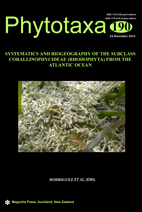Abstract
Nongeniculate calcareous algae are bio-constructors of many marine habitats, some of which are considered biodiversity hotspots. The genus Sporolithon is widely distributed around the world. As part of a review of material from the Brazilian continental shelf we found Sporolithon episoredion, that extend its distribution range into the Atlantic Ocean, Sporolithon ptychoides, which is widely distributed across oceans, and a new species of this genus named Sporolithon elevatum sp. nov. This species presents sorus 2–3 cells elevated above the thallus that sloughs off when senescent, paraphyses with 2–3 cells and a basal layer of elongated cells in areas where sporangia develop. The new species was found at 133 m depth. This study contributes to the understanding of the diversity in this genus and indicates the importance of systematic studies in the framework of conservation programs and evaluation of impacts in an area under exploitation activities.

